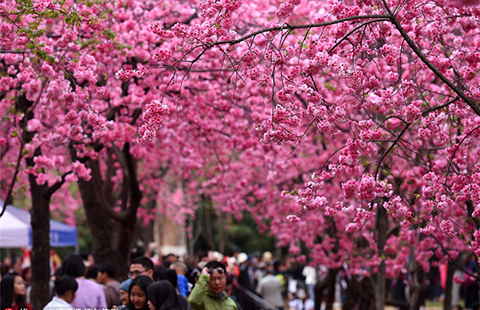Full Text: Freedom of Religious Belief in Xinjiang
Updated: 2016-06-02 16:46
(Xinhua)
|
||||||||
BEIJING -- The State Council Information Office of the People's Republic of China published a white paper titled "Freedom of Religious Belief in Xinjiang" on Thursday.
Following is the full text of the white paper:
Freedom of Religious Belief in Xinjiang
The State Council Information Office of the People's Republic of China
June 2016
Contents
Foreword
I. History of Religions in Xinjiang
II. Protecting Citizens' Freedom of Religious Belief
III. Satisfying Believers' Normal Religious Requirements
IV. Managing Religious Affairs in Accordance with the Law
V. International Religious Exchanges
VI. Preventing and Combating Religious Extremism
VII. Active Role of Religious Circles
Conclusion
Foreword
The Xinjiang Uygur Autonomous Region (Xinjiang for short) is located in northwest China. For thousands of years it has been a multi-ethnic region of multiple religions. At present, the major religions in Xinjiang are Islam, Buddhism, Protestantism, Catholicism and Taoism.
Historically, religious relations in Xinjiang were very complicated. Before the People's Republic of China was founded in 1949 many conflicts had occurred between different religions or different sects of the same religion; some areas even experienced decades of religious wars and centuries of sectarian strife. Religious wars and conflicts not only caused serious damage to the economy and society, but also brought grave disasters to the people. As a result, people lost freedom of faith.
After the People's Republic of China was founded, people of all ethnic groups in Xinjiang gained the freedom of religious belief. The central government and local governments at all levels of Xinjiang have fully implemented the system of regional ethnic autonomy and the policy on the freedom of religious belief, and constantly improved laws and regulations on the administration of religious affairs. All religions in Xinjiang have thus reached a new historical stage at which they coexist in harmony.
To let the peoples of the rest of the world know the real situation of religious freedom in Xinjiang, this paper hereby makes a brief introduction and explanation.
I. History of Religions in Xinjiang
The evolution of religions in Xinjiang was a long historical process. The ancient residents of Xinjiang developed primitive religious ideas as early as in the Neolithic Period. From the fourth century BC, Zoroastrianism, Buddhism and some other faiths were introduced into Xinjiang one after another. Gradually there came into being a pattern wherein a variety of religions coexisted, which continues today.
The evolution of religions in Xinjiang went through four stages: the stage of primitive religion, the formation stage for the coexistence of a variety of religions with Buddhism as the major one, the evolution stage for the coexistence of many religions with Islam and Buddhism as the two major ones, and the development stage for the coexistence of a variety of religions with Islam as the major one.
Before the fourth century BC primitive religion was practiced in Xinjiang. Many ethnic groups of Xinjiang still retain some concepts and practices of primitive religion to different degrees. Later, Zoroastrianism was introduced into Xinjiang via Central Asia. Around the first century BC Buddhism was introduced into Xinjiang, and gradually a pattern came into being wherein many religions coexisted with Buddhism as the major one. From the fourth to the 10th century Zoroastrianism became prevalent throughout Xinjiang, particularly in the Turpan area. For this, the local authorities of Gaochang set up a special administrative agency. During this same period Buddhism reached its peak. In oases on the periphery of the Tarim Basin Buddhist temples arose in great numbers, with a multitude of monks and nuns. Khotan, Kashgar (Shule), Kucha (Qiuci), Gaochang and other famous Buddhist centers took shape. Taoism was introduced into Xinjiang around the fifth century, becoming prevalent mainly in Turpan and Kumul (Hami). It spread to most parts of Xinjiang in the Qing Dynasty (1644-1911). Manichaeism and Nestorianism were introduced into Xinjiang one after the other in the sixth century. In the middle of the ninth century, the Huihu people, who believed in Manichaeism, entered the Turpan area, where they built temples, dug caves, translated scriptures and painted frescoes. From the 10th to the 14th century, Nestorianism flourished as the Huihu people and some other ethnic peoples converted to it in many parts of Xinjiang. At that time Nestorianism was preached in Kashgar, Yarkant, Khotan, Bugur (Luntai), Gaochang, Hami, Almaliq (now in Huocheng County), and a few other places.
In the late ninth and early 10th centuries, Islam was introduced into southern Xinjiang, changing the religious pattern of Xinjiang again. After the Kara-Khanid Khanate accepted Islam, in the mid-10th century it launched a religious war against the Buddhist Kingdom of Khotan, which lasted more than 40 years. In the early 11th century the Kara-Khanid Khanate conquered Khotan and imposed Islam in that region. Thereafter, Islam dominated southern Xinjiang while Buddhism dominated northern Xinjiang, the two coexisting. In the early period of this stage Zoroastrianism, Nestorianism and Manichaeism were also very popular. But with the spread of Islam, these religions gradually declined.
The rulers of the Eastern Chagatai Khanate in the mid-14th century spread Islam to the northern edge of the Tarim Basin, Turpan Basin and Hami area by warlike and other compulsory means. By the early 16th century many religions coexisted in Xinjiang, with Islam as the predominant one. Zoroastrianism, Manichaeism and Nestorianism gradually disappeared, although Buddhism and Taoism clung on. In the early 17th century the Oirat Mongols accepted Tibetan Buddhism. Beginning in the 18th century, Protestantism, Catholicism and the Eastern Orthodox Church were introduced into Xinjiang one by one. A pattern featuring coexistence of multiple religions, with Islam as the principal one, continues today in Xinjiang.
The religious history of Xinjiang shows that coexistence of multiple religions with one or two dominant was a basic characteristic, and blending and coexistence made up the mainstream religious relationships of Xinjiang. A religion should adapt itself to the times and human environment, and achieve localization, so that it can continue. History shows that wars between different religions and disputes between different sects of the same religion deprive people of the free choice of religion.
- Swiss declare Alps tamed as Gotthard rail tunnel opens
- China urges Japan to properly settle Chinese forced laborers issue
- Searching for remains of Dead Sea Scrolls
- China-US relations shouldn't be hijacked by S. China Sea issue
- To cool you off: The fountain in Washington Square Park
- Americans warned about terror risk this summer

 Performers wanted for Shanghai Disney park
Performers wanted for Shanghai Disney park
 New law protects ancient villages in Southwest China's Lhasa
New law protects ancient villages in Southwest China's Lhasa
 Kids with HIV in Shanxi's Red Ribbon School
Kids with HIV in Shanxi's Red Ribbon School
 Heavy rain turns Wuhan into 'seaside' city
Heavy rain turns Wuhan into 'seaside' city
 Photos: Little royals on the Children's Day
Photos: Little royals on the Children's Day
 Pure love: Chinese 'little prince'and his fox
Pure love: Chinese 'little prince'and his fox
 Then and now: Recreating that child-like smile
Then and now: Recreating that child-like smile
 Young teacher's heartfelt love for the students
Young teacher's heartfelt love for the students
Most Viewed
Editor's Picks

|

|

|

|

|

|
Today's Top News
Chinese State Councilor Yang Jiechi to meet Kerry
Chinese stocks surge on back of MSCI rumors
Liang avoids jail in shooting death
China's finance minister addresses ratings downgrade
Duke alumni visit Chinese Embassy
Marriott unlikely to top Anbang offer for Starwood: Observers
Chinese biopharma debuts on Nasdaq
What ends Jeb Bush's White House hopes
US Weekly

|

|







